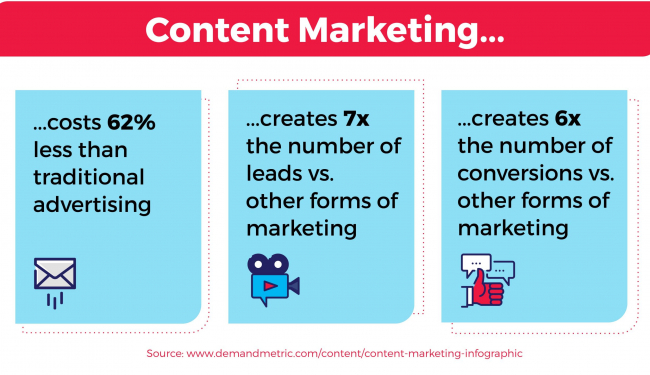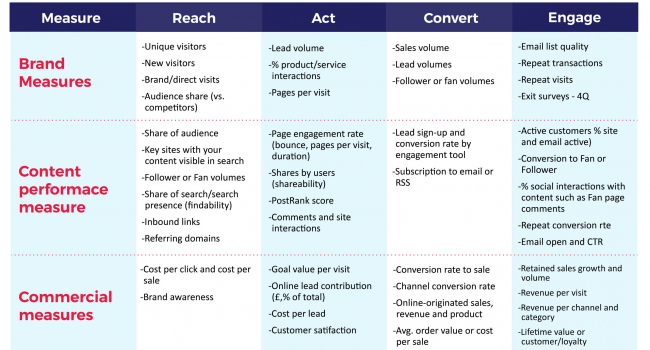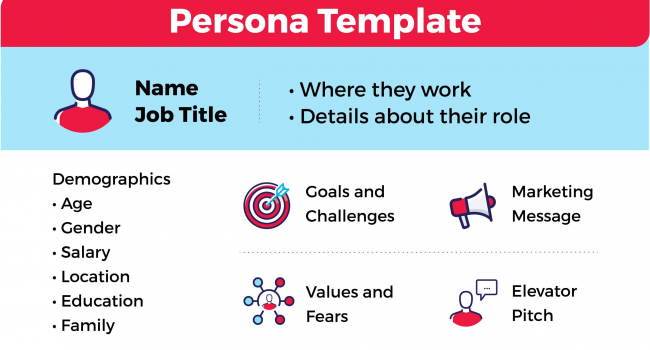Content marketing is the only marketing left.
– Seth Godin
Introduction
Marketer and author Seth Godin’s iconic quote is even more relevant today. The traditional way of marketing to customers — the one-way firehose — is dead. In an age where people have access to all the information ever collected through a mobile device, it’s becoming increasingly difficult for people to choose who to do business with. One of the biggest challenges people face is deciding who to trust, as we all know our online movements are being watched by retailers looking for the opportunity to sell us something. How can you break through and reach your customers with your message? Use content marketing.
According to Forrester Research, “Content Marketing is a strategy where brands create interest, relevance, and relationships with customers by producing, curating, and sharing content that addresses specific customer needs and delivers visible value.”
Content marketing provides potential customers with much more than valuable information — it’s giving them a reason to trust you. If done well, content marketing will help transform potential customers into actual customers and then into fans who will tell others about you.
The history of content marketing
Content marketing is not a new concept — people have been using stories to sell their ideas and products since the beginning of time, and there is no chance of that slowing down.
Highlight: John Deere - A Content Marketing Pioneer

John Deere was one of the first to employ a content marketing strategy to build trust and sell more products.
John Deere, a well-known farming equipment company, was originally founded in 1837. While the brand enjoyed moderate success in the first few decades of existence, its foray into content marketing catapulted it to become a household name.
In 1895 the company created a magazine called The Furrow, which was meant to cater to farmers with “practical information devoted to the interests of better farming.” By 1912 the magazine had a circulation size of over 4 million and it’s still being published today. The key to the success of the magazine was that it always focused on providing value to the potential customer through useful information, not advertisement. In fact, with the exception of the small inscription that said “with compliments of your John Deere dealer.” The magazine ran no ads, and the articles included within the little magazine didn’t focus on John Deere’s products. Instead, they covered topics ranging from how best to address various farming challenges to trends in the agricultural community as a whole.
The case for content

Still not convinced? Here’s why content should matter to your organization:
- Content marketing matters to search engines: People look to search engines to solve their problems, so it only makes sense to be featured prominently. One of the best ways to achieve a high ranking in an organic search is through the development and promotion of timely, relevant content. Google’s algorithm rewards up-to-date, authentic (not keyword “spammy”) content with higher scores which will mean more people will see it through searches.
- 600 million devices now use ad blockers: Online advertising is still a good way to drive traffic to your website, but it is becoming an increasingly complex world that often requires honed expertise to navigate. Marketers can’t rely on online ads alone; a content marketing strategy will help to enhance digital ads to drive greater results at a lower cost.
- It drives traffic: Content marketing leaders experience 7.8 times more site traffic than non-leaders, “people who succeed at becoming leaders in the world of content marketing — people who craft compelling, valuable content that gets to the heart of their readers — experience drastically more site growth than their competitors.” – Neil Patel
- It’s cheaper: Content marketing is cheaper than traditional channels, costing on average 62% less than traditional channels.
- It drives higher conversions: Use of content marketing strategies produce conversion rates (i.e. the percentage of website visitors who follow through on specified actions, such as clicking a link button) that are nearly six times higher than traditional strategies.
Your competition is already there: Millions of brands in Canada and worldwide already have established content strategies. Every day they are engaging new people who they will convert into their next customers, sponsors and partners. You can’t afford not to be in this space.
Lego: A content marketing success story

One example of content marketing done right is the toy giant Lego. In recent years it has dramatically increased its branded content through magazines, social media and movies.
This shift has transferred Lego into one of the biggest toymakers in the world, along with millions of followers on social media and consistent revenue growth.
The company is so successful because the content they produce (movies, magazines, videos, pictures, and message boards) creates a sense of community that its customers crave.
How to get started in content marketing
Developing a content marketing strategy can seem complex, but broken down into a set of easy-to-follow steps creates a path to success:
1. Get buy-in: First and foremost, if you work at a medium to large organization that has never had a content marketing strategy you need to get organizational buy-in. Although the benefits are clear, producing timely, relevant content can be challenging and time-consuming at first; so you need to ensure you have the resources and support available from your colleagues to execute efficiently.
- Tip: Develop an internal case-making pitch, if necessary draw on supporting statistics in this document (and online) and outline the problem that content marketing will help solve at your organization.
2. Set Clear, Realistic Goals: Setting clear, measurable goals is a vital first step in any marketing strategy. Think about what you want this strategy to achieve, set goals and track them.
- To start off, objectives could be based on growing your reach or audience in social media, increasing the number of people who visit your website, or driving online donations.
- As your team progresses and becomes more sophisticated, more key performance indicators (KPIs) can be added to suit your strategies. See the examples below. Remember though: a content marketing strategy takes time to optimize and yield results; manage your expectations and those of your colleagues accordingly.

3. Know your audience: Once you’ve set your objectives, the next step is understanding who you are trying to reach, what they value and what problem you are solving for them with your content. Each business/organization is different and will have unique events or issues to focus on … the bottom line is that you have to offer value. Don’t just revert to the firehose and push out what you want them to know — give them what they want.

Drill down even further on your target audience(s) by using a persona creation model. By leveraging data from your website analytics, customer databases and other sources you can start to create model segments of your customer base with clearly articulated attributes and needs that will help your marketing strategy be more effective.
By developing personas, you will tease out key traits and characteristics about large groups of your market, which will in-turn direct the content you produce, along with how, where and when you promote it.
Here’s an example of a persona template you can replicate for your strategy. Expect to develop at least four to six of these personas, based on the distinct audiences you’re trying to reach.

4. Do your SEO research: Once you’ve created your audience personas you should be able to start coming up with ideas about what questions they might have about your products/services. Before you start to put the effort into writing, do your search engine optimization (SEO) research to get a sense of how many people are searching for answers to those questions.
The easiest way to approach this research is to come up with specific questions and see what comes back on a search engine query. Depending on the popularity of the keywords in your search you should get a sense of how popular they are. You’ll want to try and find a niche for your products or services rather than going after the most popular keywords right away. You can also use keyword research tools via Google and Moz to help guide your efforts.

Good stories get retold around kitchen tables and campfires…bad ones disappear forever.
5.Find your story: Storytelling is as old as human civilization itself and is the original word-of-mouth marketing. Good stories stand the test of time, they get retold around kitchen tables and campfires; bad ones disappear forever. These days, with the speed of social media, stories spread quickly. Therefore, to be successful your stories need to capture your audience’s attention and resonate with individuals on a personal level.
To create good content, you need to think like a journalist. We recommend using leading brand content consultant Melanie Deziel’s “truth” model:
Timely: Right content at the right time – take advantage of new items or trends
Reputable: Tap into your unique knowledge and expertise around local community issues
Unique: Don’t produce the same content everyone else is pushing – create something unique that stands out and gets you noticed
Tension: Tell stories that are unresolved, that give readers an opportunity to get involved
Human Condition: Tell emotional stories, not only are they more memorable but they will drive engagement
Beyond the catchy acronym, brands must remember to always be truthful. In the age of ‘fake news’ you don’t want your brand to be peddling false information.
6. Keep the language simple: Remember your audience, and write for them. Use simple language that everyone can understand — avoid buzzwords or complex industry terms.
7. Establish your boundaries: Ensure you have established the boundaries of your content development and know what the organizational position is on key issues. In the early days, shop draft content around the organization so other teams can get a feel for what will be pushed out and can provide feedback and comments to ensure alignment with current/historical positions on key issues.
8. Share Your Success: Tell the stories of those in your organization’s orbit. Engage your supporters to share their experiences with your brand to unlock word of mouth marketing and tap into new audiences who you may not have had access to before.
Promote your content
- Develop a process
Once you’ve developed your brand voice, you need to develop a process for producing and getting all your great content in front of your target audience(s).
- Map out the content marketing process, from idea generation to approvals to posting, and make sure all involved in the organization are clear on their roles
- Establish brand guidelines and editorial standards for content marketing, so colleagues know what is acceptable to publish and what is not — this may be difficult at first but will become much easier as you develop more material
- Know the promotion channels that you’re going to use and research the best practices for posting in those channels to maximize exposure
Identify resources needed to produce content (e.g. video, graphic design, podcasting, writing); if they aren’t available internally determine how to access them when support is needed - Determine what training is required for staff to maximize content efforts
- Agree to formal and informal communications processes within your organization to be able to quickly leverage emerging issues while setting reasonable expectations.
Use a content calendar
A content calendar that lays out what you’re going to post is one of the most important tools you will employ in your marketing strategy. Not only will it save you time, but it will also keep you and your team organized and on-track from a strategy perspective. Most importantly, it keeps your readers and audience engaged by ensuring your content doesn’t become redundant.
There are many tools available at varying prices — from large end-to-end content management tools all the way down to an Excel spreadsheet. However, you choose to track your content development, make sure you include the following information:
- Title
- Format (e.g. video, blog, image, podcast, etc.)
- Target audience
- Goal/Action
- Promotional channels
- Date
- Success measure
Social media promotion
A reality of social media channels today is the need to use paid promotion to ensure your content gets to the largest number of people in your target audience. See the Social Media Strategies module for more channel-specific details on this.
Manage conversations
Once your content is out, manage the conversations that are happening in the channels you published it in. Be helpful, answer questions, clarify information if necessary and follow the social media guidelines that have been established organizationally… especially when dealing with negative comments.
Measure, test and share successes
- Just because you can measure almost anything these days, doesn’t mean that you should. Metrics can be all-consuming and confusing, so first, use some of the suggested KPIs (key performance indicators) referenced earlier in this document or establish some that fit your unique needs.
- Testing is the only way to truly eliminate the guesswork from your content strategy. You may think you know which day of the week is best to post, what channels your audiences favour or even the best tone to use in your writing. However, unless you test and measure you’re still just guessing and giving your audience what you think is best. You can do simple tests to help you understand when and where to post, what headlines work best, what medium drives the most conversions and many other optimization tweaks.
Create a testing plan, develop a hypothesis and start testing today.
- Sharing successes is one of the most important parts of your content strategy. It lets your staff and volunteers know that strategies are working and that you are seeing results. Find a formal or informal way to share your successful content marketing efforts and keep reporting on them regularly.
Summary
The content management information provided is just the tip of the iceberg compared to how much you’ll learn by just starting to produce and promote your brand story through content marketing. Get started today and be sure to share your successes with the rest of the movement.